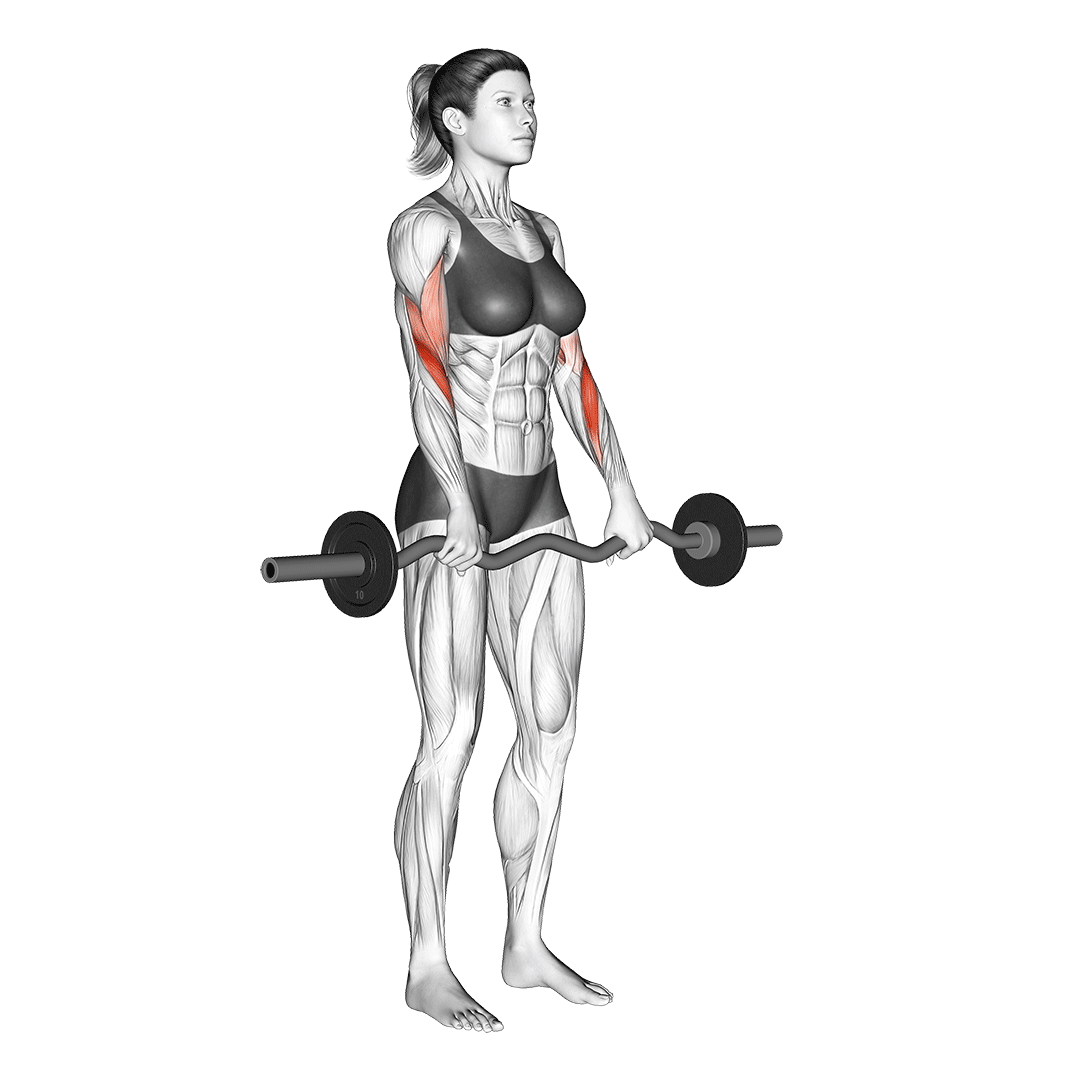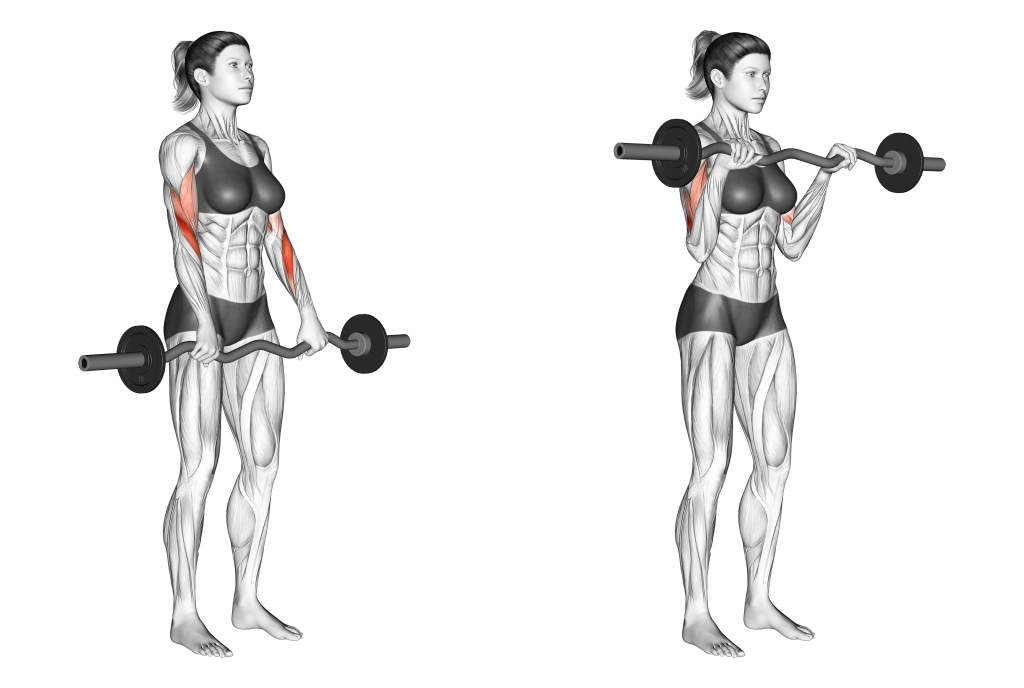Reverse Grip EZ Bar Curls Exercise Overview: Muscles Worked and More
The reverse grip EZ bar curl is a forearm isolation exercise primarily targeting the brachioradialis and brachialis muscles through elbow flexion.
The actual technique used for performing the movement is quite similar to that of a supinated curl, only with a pronated grip being used instead.
The forearms are raised and lowered while the upper arms are kept stationary, reducing involvement of the biceps brachii and shifting it to other elbow flexors instead.
Reverse Grip EZ Bar Curls at a Glance
Equipment Requirements
EZ Curl Bar, Weight Plates
Main Muscles Targeted
Brachioradialis, Brachialis, Biceps Brachii (Elbow Flexor Muscle Group)
Difficulty
Easy
Sets, Reps, and Load Recommendations
3-5 Sets of 12-16 Repetitions at a Light Load
How to Do Reverse Grip EZ Bar Curls
- To perform a repetition of the reverse grip EZ bar curl, the lifter begins by holding an EZ bar at the front of their body, arms loosely extended, the elbows tucked close to the sides of the ribs and the hands in an overhand orientation.
The shoulders should be neutrally rotated with the trunk kept upright and entirely stationary throughout the set. No force should be generated by any muscles other than the elbow flexors. - Once positioned correctly, the lifter proceeds to squeeze their forearms and draw the bar upwards towards their shoulders - bending the elbows as they do so.
- When the lifter can no longer raise the bar any higher and the forearms are pressed firmly against the biceps, they then reverse the movement in a slow and controlled manner.
- With the bar now returned to the front of the legs and the elbows extended once more, the repetition is considered complete.
Additional Tips:
Lifters may find that properly contracting their brachialis muscles is made easier by squeezing the elbows against the sides of the body. So long as they remain otherwise stationary, doing so can be an effective way of ensuring the right muscles are contracted.
What Muscles do Reverse Grip EZ Bar Curls Work?
Though the reverse EZ bar curl is considered an isolation exercise, it can effectively also be considered a compound movement considering that the brachialis, brachioradialis and biceps brachii are all targeted to a certain degree.

Common Reverse Grip EZ Bar Curls Mistakes to Avoid
To ensure the right muscles are recruited during each repetition, avoid the following highly common mistakes.
Moving the Elbows
One of the most important aspects of any curl exercise is elbow positioning, as it dictates the extent to which the elbow flexor muscles themselves can be activated.
Moving the elbows can cause other muscle groups to bear the bar’s weight, shifting emphasis away from the brachialis and brachioradialis while simultaneously increasing the risk of bicep, elbow and wrist injury.
Throughout the entire set of EZ bar reverse curls, the elbows should remain stationary against the sides of the ribcage.
Swinging the Torso
In a similar vein to moving the elbows, lifters may unconsciously swing their torso - thereby generating force without actually contracting the elbow flexor muscles.
Apart from negating the purpose of the exercise, swinging the torso can increase the risk of lower back injury and lead to further errors in technique.
In most cases, performing the reverse grip EZ bar curl in this manner is a sign that too much weight is being lifted. Proper technique should be prioritized over how much weight is being moved.
Using an Excessively Wide Grip
Depending on the specific dimensions of the EZ bar used, lifters may accidentally position their hands too far apart.

While a perfectly valid exercise in its own right, the hands being positioned at such a distance will reduce the involvement of the brachioradialis muscle.
If thicker and larger forearms are among the lifter’s goals, a shoulder-width or somewhat narrower position will be needed.
Extending or “Rolling” the Wrists Back
The EZ curl bar is most often employed as a straight bar alternative for lifters that find the latter too strenuous on the wrists.
Unfortunately, the EZ bar reverse curl can still strain and injure the wrists if performed incorrectly - particularly by extending the wrists or otherwise allowing them to roll backwards.
Extending the wrists with a heavy load held in the hands increases strain on the tissues of both the flexor and extensor muscles while simultaneously destabilizing the movement.
Throughout the set, lifters should focus on keeping the wrists straight and aligned with the rest of the forearms. Constantly needing to extend the wrists to move the bar may be a sign of poor mobility somewhere up the chain, or simply that too much weight is being lifted.
Who Should Do Reverse Grip EZ Bar Curls?
The reverse grip EZ bar curl is among one of the safest variations of curl out there. So long as attention is paid to proper positioning, there is very little that can result in injury while the exercise is being performed.
Of course, if you have a history of wrist or elbow injuries, it is best to first seek out medical approval prior to attempting any form of curl.
References
1. Marcolin G, Panizzolo FA, Petrone N, Moro T, Grigoletto D, Piccolo D, Paoli A. Differences in electromyographic activity of biceps brachii and brachioradialis while performing three variants of curl. PeerJ. 2018 Jul 13;6:e5165. doi: 10.7717/peerj.5165. PMID: 30013836; PMCID: PMC6047503.

